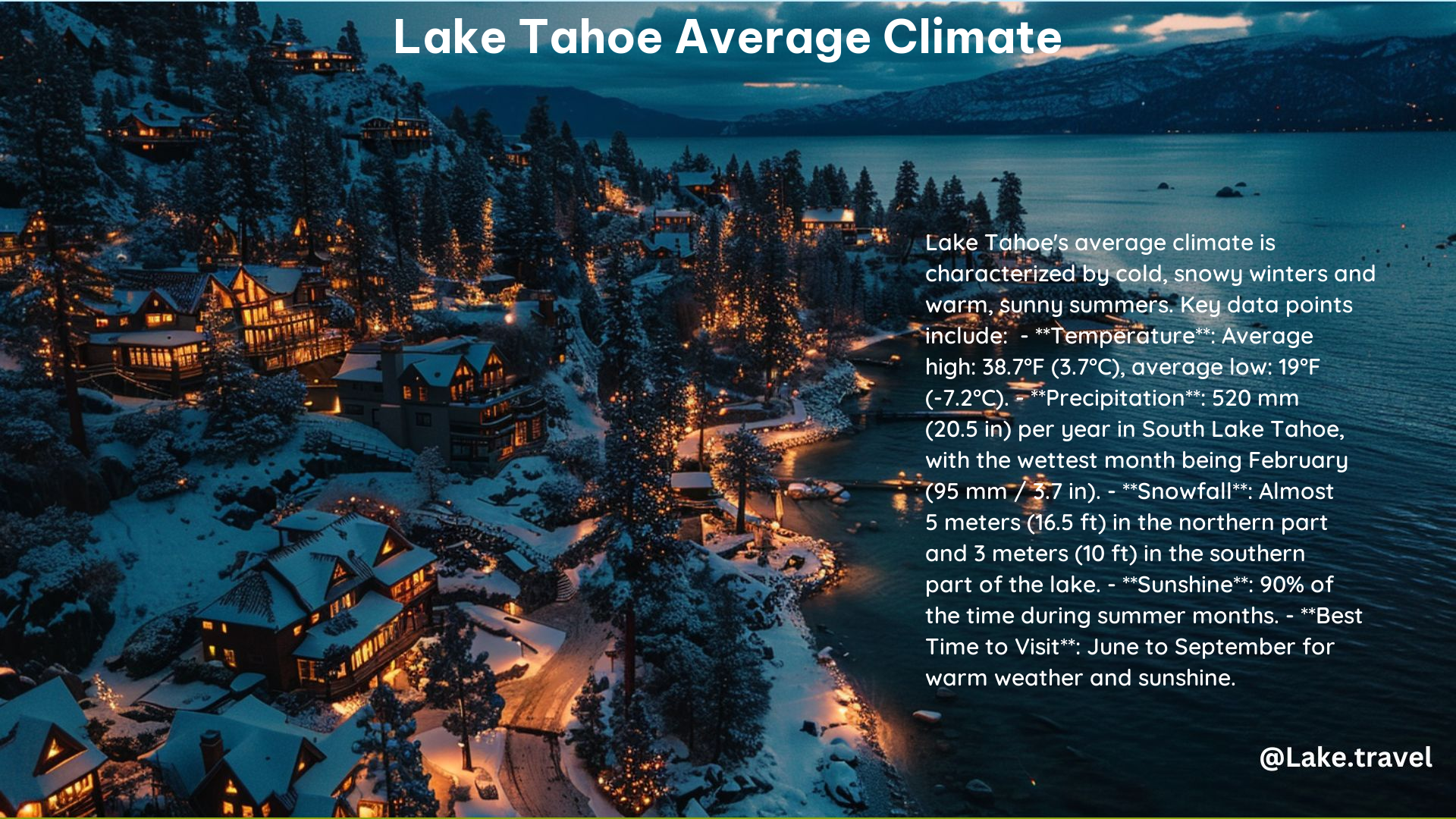Lake Tahoe, nestled in the Sierra Nevada mountains, is renowned for its stunning natural beauty and diverse range of outdoor activities. As a lakes touring enthusiast, understanding the average climate of this captivating destination is crucial for planning your adventures. In this comprehensive guide, we’ll delve into the intricacies of Lake Tahoe’s climate, providing you with the essential information you need to make the most of your visit.
Exploring the Temperatures of Lake Tahoe
Lake Tahoe’s climate is characterized by its distinct seasonal variations, offering a range of temperature experiences throughout the year. Let’s take a closer look at the temperature patterns:
Annual High Temperature: 54°F (12.2°C)
Annual Low Temperature: 34°F (1.1°C)
Summer Highs: 69°F to 77°F (20.6°C to 25°C)
Winter Highs: 38.7°F (3.7°C) to 40.3°F (4.6°C)
These temperature ranges create a diverse landscape, allowing visitors to enjoy a variety of outdoor activities, from swimming and boating in the summer to skiing and snowshoeing in the winter.
Precipitation Patterns at Lake Tahoe

Precipitation plays a significant role in shaping the climate of Lake Tahoe, and understanding these patterns is crucial for planning your lakes touring experience. Let’s dive into the details:
Average Annual Precipitation: 52.43 inches (133.1 cm)
Average Annual Snowfall: 408 inches (1036.8 cm)
Monthly Precipitation: Ranges from 0.28 feet (7 mm) in July to 5.98 feet (152 mm) in January
The significant snowfall during the winter months transforms the region into a winter wonderland, making it a prime destination for snow sports enthusiasts. However, the variable precipitation patterns throughout the year can also impact the water levels and accessibility of certain areas, so it’s essential to plan accordingly.
Sunshine and Daylight Hours at Lake Tahoe
Lake Tahoe is renowned for its abundant sunshine, which plays a crucial role in the overall climate and outdoor experience. Let’s explore the details:
Average Sunshine Hours: 90% of the time during summer months
Daylight Hours: Varies from 9 hours and 48 minutes in January to 14 hours and 52 minutes in June
The long, sunny days during the summer months create the perfect conditions for a wide range of outdoor activities, from hiking and kayaking to simply enjoying the stunning lake views. The shorter daylight hours in the winter months, on the other hand, can be ideal for stargazing and enjoying the cozy ambiance of the region.
Unique Weather Patterns at Lake Tahoe
Lake Tahoe’s climate is not only defined by its temperatures, precipitation, and sunshine, but also by its unique weather patterns that can impact your lakes touring experience. Let’s take a closer look:
Mountain Weather: The mountainous terrain of Lake Tahoe can lead to rapidly changing weather conditions, with strong winds and sudden storms that can catch visitors off guard.
Washoe Zephyr: A daily phenomenon where winds from the southwest create challenging paddle conditions, requiring extra caution and preparation for water-based activities.
Cold Water Shock: The cold water temperatures in Lake Tahoe pose a significant risk, as they can cause involuntary gasps, difficulty breathing, or muscle failure, making water safety a top priority.
Understanding these unique weather patterns can help you better prepare for your lakes touring adventures and ensure a safe and enjoyable experience.
Best Time to Visit Lake Tahoe
Depending on your interests and preferences, the best time to visit Lake Tahoe can vary. Here’s a general guide to help you plan your trip:
Summer (June to September): Ideal for warm weather and a wide range of outdoor activities, such as swimming, boating, hiking, and exploring the lake’s stunning natural beauty.
Winter (December to February): Perfect for snow sports enthusiasts, with abundant snowfall and opportunities for skiing, snowboarding, and snowshoeing.
Regardless of the season, Lake Tahoe offers a unique and captivating experience for lakes touring enthusiasts. By understanding the average climate, you can better prepare for your adventure and make the most of your time in this breathtaking destination.
Conclusion
Lake Tahoe’s average climate is a complex and dynamic system that offers a diverse range of experiences for lakes touring enthusiasts. From the warm, sunny summers to the snowy, winter wonderlands, this destination truly has something to offer throughout the year. By understanding the temperature patterns, precipitation, sunshine, and unique weather conditions, you can plan your trip with confidence and ensure an unforgettable adventure in this stunning natural oasis.
Reference:
– Lake Tahoe Climate and Weather
– Lake Tahoe Average Weather and Climate
– Lake Tahoe Weather and Climate
